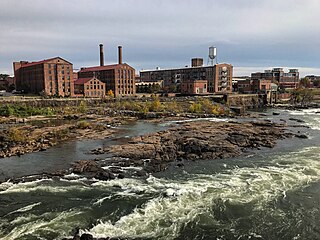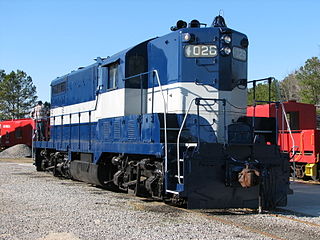
Eufaula is the largest city in Barbour County, Alabama, United States. As of the 2010 census the city's population was 13,137.

Opelika is a city in and the county seat of Lee County in the east-central part of the U.S. state of Alabama. It is a principal city of the Auburn-Opelika Metropolitan Area. As of the 2010 census, the population of Opelika was 26,401, and in 2019 the estimated population was 30,908. The Auburn-Opelika, AL MSA with a population of 150,933, along with the Columbus, Georgia metropolitan area, comprises the Greater Columbus combined statistical area, a region home to 501,649 residents.

West Point is a city in Troup and Harris counties in the U.S. state of Georgia. It is located approximately halfway between Montgomery, Alabama and Atlanta along Interstate 85. As of the 2010 census, it had a population of 3,474, and in 2015 the estimated population was 3,728. Most of the city is in Troup County, which is part of the LaGrange Micropolitan Statistical Area, and hence part of the Atlanta-Athens-Clarke County-Sandy Springs, GA Combined Statistical Area. A sliver in the south is in Harris County, which is part of the Columbus Metropolitan Statistical Area.

Columbus is a consolidated city-county located on the west-central border of the U.S. state of Georgia. Columbus lies on the Chattahoochee River directly across from Phenix City, Alabama. It is the county seat of Muscogee County, with which it officially merged in 1970. Columbus is the third-largest city in Georgia and the fourth-largest metropolitan area. According to the 2019 estimates from the U.S. Census Bureau, Columbus has a population of 195,769 residents, with 321,048 in the Columbus metropolitan area. The metro area joins the nearby Alabama cities of Auburn and Opelika to form the Columbus–Auburn–Opelika Combined Statistical Area, which has a 2019 estimated population of 485,590.

The Georgia Railroad and Banking Company also seen as "GARR", was a historic railroad and banking company that operated in the U.S. state of Georgia. In 1967 it reported 833 million revenue-ton-miles of freight and 3 million passenger-miles; at the end of the year it operated 331 miles (533 km) of road and 510 miles (820 km) of track.

The Atlanta and West Point Rail Road was a railroad in the U.S. state of Georgia, forming the east portion of the Atlanta-Selma West Point Route. The company was chartered in 1847 as the Atlanta and LaGrange Rail Road and renamed in 1857; construction of the 5 ft gauge line was begun in 1849-50 and completed in May 1854. A large minority interest owned by the Georgia Railroad and Banking Company eventually passed under the control of the Atlantic Coast Line Railroad (ACL), which later acquired a majority of the stock.
The Atlantic and Gulf Railroad was chartered in February 1856 by act of the Georgia General Assembly. It was also known as the Main Trunk Railroad. It traversed south Georgia from Screven to Bainbridge, Georgia. Construction began in early January 1859. Its construction was halted by the American Civil War. Construction began again after the end of the war and the line was completed to Bainbridge, Georgia by late December 1867. The route never reached all the way to the Gulf of Mexico as it had originally had intended. The company went bankrupt in 1877 and was bought in 1879 by Henry B. Plant and became incorporated into his Plant System. Its main line is currently operated by CSX Transportation. Throughout its history, the Atlantic and Gulf was closely associated with the Savannah and Albany Railroad Company and its successor the Savannah, Albany, and Gulf Railroad.
The Battle of West Point, Georgia, formed part of the Union campaign through Alabama and Georgia, known as Wilson's Raid, in the final full month of the American Civil War.
The Western Railway of Alabama (WRA) also seen as "WofA" was created as the Western Railroad of Alabama by the owners of the Montgomery & West Point Railroad (M&WP) in 1860. It was built to further the M&WP's development West from Montgomery, Alabama to Selma, Alabama. When the line was constructed in 1870, the M&WP was merged into the WRA, creating a line from Selma to West Point, Georgia. It served Auburn, Alabama and connected in Opelika, Alabama to the Central of Georgia line from Columbus, Georgia to Birmingham, Alabama. Although it was partially owned by the Central of Georgia around the turn from the nineteenth to the twentieth century, it did not end up being owned by Norfolk Southern when that company came into existence due to the merger of the CofG's parent, the Southern Railway, and the Norfolk & Western Railway.

The Georgia Southwestern Railroad is a Class III short line railroad company that operates over 234 miles (377 km) of track in southwestern Georgia and southeastern Alabama. Beginning in 1989 as a division of the South Carolina Central Railroad on a pair of former CSX Transportation lines, the railroad has since undergone a number of transformations through abandonments and acquisitions, before arriving at its current form. The railroad was formerly a RailAmerica property before going independent, and in 2008 it was acquired by Genesee & Wyoming Inc.
Wilson's Raid was a cavalry operation through Alabama and Georgia in March–April 1865, late in the American Civil War. Brig. Gen. James H. Wilson led his Union Army Cavalry Corps to destroy Southern manufacturing facilities and was opposed unsuccessfully by a much smaller force under Confederate Lt. Gen. Nathan Bedford Forrest.

Horace King was an American architect, engineer, and bridge builder. King is considered the most respected bridge builder of the 19th century Deep South, constructing dozens of bridges in Alabama, Georgia, and Mississippi. In 1807, King was born into slavery on a South Carolina plantation. A slave trader sold him to a man who saw something special in Horace King. His owner, John Godwin taught King to read and write as well as how to build at a time when it was illegal to teach slaves. King worked hard and despite bondage, racial prejudice and a multitude of obstacles, King focused his life on working hard and being a genuinely good man. King built bridges, warehouses, homes, churches, and most importantly, he bridged the depths of racism. Ultimately, dignity, respect and freedom were his rewards, as he transcended the color lines inherent in the Old South of the nineteenth century. Horace King became a highly accomplished Master Builder and he emerged from the Civil War as a legislator in the State of Alabama. Affectionately known as Horace “The Bridge Builder” King and the "Prince of Bridge Builders," he also served his community in many important civic capacities."
The Pine Belt Southern Railroad was a shortline railroad formerly operating on two disconnected track segments in east central Alabama. Upon its start in 1995 the railroad ran over a branch from Nuckols to Hurtsboro, Alabama. In 1996 a second branch was acquired, extending from Roanoke, Jct., near Opelika, to Lafayette, Alabama. Together the lines totaled 42.4 miles (68.2 km) and the railroad was controlled by Richard Abernathy.
The 72nd Indiana Infantry Regiment, also known as 72nd Indiana Mounted Infantry Regiment, was an infantry and mounted infantry regiment that served in the Union Army during the American Civil War. The regiment served as mounted infantry from March 17, 1863, to November 1, 1864, notably as part of the Lightning Brigade during the Tullahoma and Chickamauga Campaigns.

The Mobile & Girard Railroad was an Alabama railroad which was constructed in the mid-19th century; a portion of the line continues in operation under different ownership. The 26-mile (42 km) line was constructed with a track gauge of 5 ft.
The Battle of Columbus, Georgia, was the last conflict in the Union campaign through Alabama and Georgia, known as Wilson's Raid, in the final full month of the American Civil War.

The Pensacola and Atlantic Railroad (P&A) was a company incorporated by an act of the Florida Legislature on March 4, 1881, to run from Pensacola to the Apalachicola River near Chattahoochee, a distance of about 160 miles (260 km). No railroad had ever been built across the sparsely populated panhandle of Florida, which left Pensacola isolated from the rest of the state. William D. Chipley and Frederick R. De Funiak, both of whom are commemorated in the names of towns later built along the P&A line, were among the founding officers of the railroad company.

The Tuskegee Railroad was a 5 and 1/2 mile long railroad that connected Tuskegee, Alabama to the Montgomery and West Point Railroad at the nearby village of Chehaw. First constructed in 1860 by the Tuskegee Rail Road Company, it was subsequently destroyed in the American Civil War and then sold to E. T. Varner & Company, which rebuilt it and reincorporated it as the Tuskegee Railroad Company in 1872. Again incorporated in 1902 as the Tuskegee Railroad, one of the railroad's primary purposes in the early 20th century was to connect the Tuskegee Institute to other railroad lines.
The Alabama and Florida Railroad was a line of rail track connecting Pensacola, Florida with Montgomery, Alabama during the late 1850s and early 1860s. The portion of the line in Alabama was first owned by the Alabama and Florida Rail Road Company, while the portion of the line in Florida was owned by the Alabama and Florida Railroad.











